Canada Residential Construction Market Size
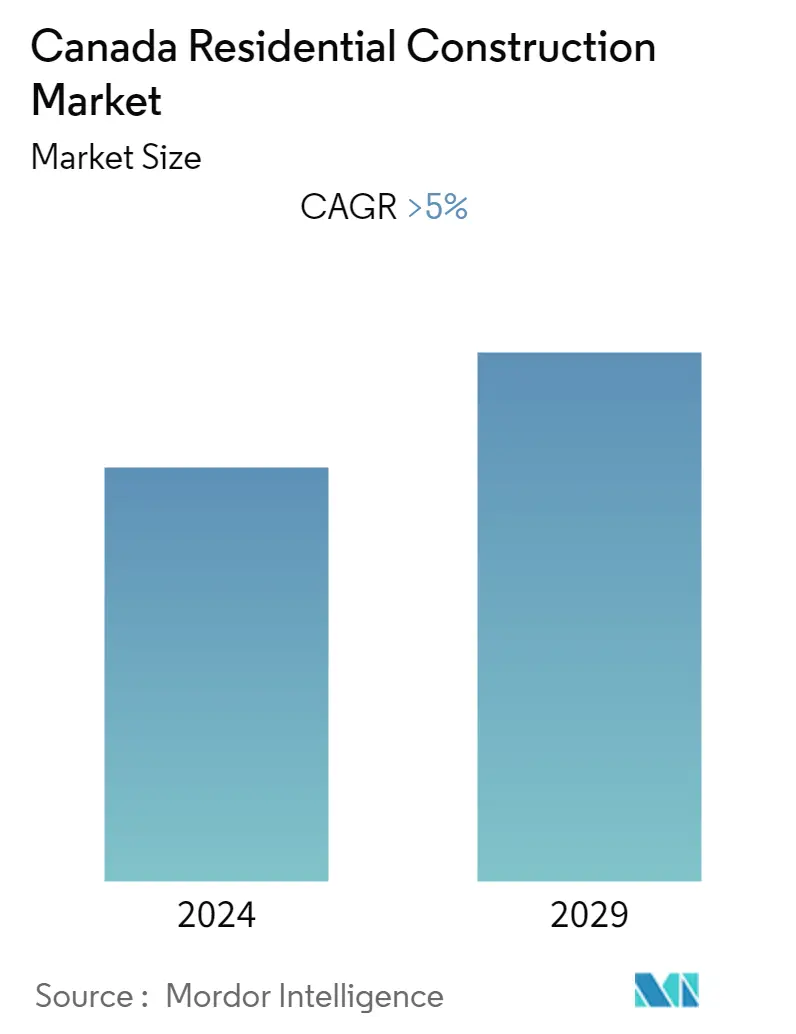
| Study Period | 2020 - 2029 |
| Base Year For Estimation | 2023 |
| Forecast Data Period | 2024 - 2029 |
| Historical Data Period | 2020 - 2022 |
| CAGR | 5.00 % |
| Market Concentration | Low |
Major Players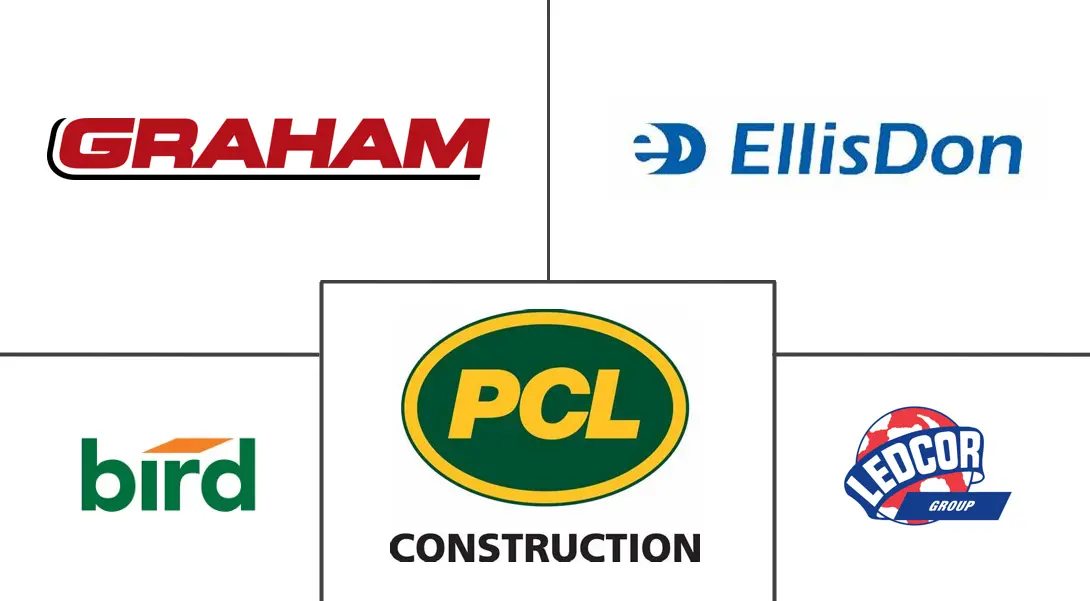
*Disclaimer: Major Players sorted in no particular order |
Canada Residential Construction Market Analysis
The Canada residential construction market is estimated to register a CAGR of greater than 5% during the forecast period.
- The construction industry was deemed essential and operations were able to continue through government-imposed restrictions and lockdowns. Nonetheless, weak economic activity and uncertainty weighed heavily on the sector. However, despite the slowdown during the initial months of the COVID-19 pandemic, challenging lumber and product material prices, and shortages, the residential construction industry was a key driver in Canada's economy in 2020.
- In the first half of 2022, housing starts were mixed across Canada's largest urban centers. Rental construction was generally resilient, due to strong demand for this type of housing, while developers took a more cautious approach to start new condominium apartment projects, due to the higher interest-rate environment.
- Increases in construction costs and materials shortages were also felt across markets, impacting construction times and the affordability of the housing delivered. After a boom recorded in 2021, housing starts in the country's six largest census metropolitan areas (CMAs) fell 5% in the first half of 2022. The decrease in apartment construction (-9%) is the main cause of this drop. On an annualized basis, however, housing starts in the first half of 2022 remained high compared to the level of construction over the past five years.
- In the Vancouver CMA, housing starts declined by about 25% in the first half of 2022. This slowdown was mainly due to a decrease in the number of condominium apartments started, owing to the greater number of rental apartments started. Vancouver's low vacancy rate, in a more uncertain economic environment for buyers, led residential property developers to turn to the rental segment.
- After hitting historic levels in 2021, apartment starts also declined. Toronto had the largest number of housing starts in the first half of 2022 (19,520, up 7%). While the construction of apartments and row houses increased in Toronto, the construction of generally less affordable housing types (single-detached and semi-detached houses) decreased. In Ottawa, housing starts declined for almost all dwelling types.
- The decrease was particularly significant in the single-detached and condominium apartment segments, where the level of construction was very high between January and June of 2021. Rental apartments, however, recorded an increase, with low vacancy rates stimulating construction. The effects of rising interest rates and construction costs could have an even greater impact on housing starts in the coming months.
Canada Residential Construction Market Trends
This section covers the major market trends shaping the Canada Residential Construction Market according to our research experts:
Drop in Building Permits Due to High Interest Rates
In a climate of climbing interest rates and high inflation, Canada is seeing a notable drop in building permits. According to Statistics Canada (StatCan), the value of Canada's building permits fell by the most on record in September 2022 - a clear indication of the trying economic times. According to StatCan data, the total value of building permits for the month plummeted a dramatic 17.5% from August 2022 to USD 10.2 billion. This marks the sharpest monthly decline on record. Quarterly, the country's building permits were down 6.3% between July and September - to USD 33.7 billion - after three consecutive quarters of increases. Year-over-year, the overall value of permits issued in September was down 2.5%. The notable drop was seen in both residential and non-residential sectors, with both sectors posting declines for the first time since September 2019. In the residential sector, permits dropped 15.6% from the previous month to USD 7.04 billion. This was weighted heavily by a drop of 21.2% in multifamily dwelling permits, a figure that is largely attributed to a 40% drop in Ontario from a record-high in August. Meanwhile, construction intentions for single-family homes dropped 7.7%, with notable declines in Ontario, Manitoba, and Alberta.
Canadian building permits slipped for a second month in a row in October 2022, driven by a drop in the residential sector. The total value of building permits for October fell 1.4% from the previous month to a seasonally adjusted CAD 9.99 billion (USD 7.42 billion). On a year-over-year basis, the overall value of permits issued in October was down 6.3%. According to StatCan, building permits provide an early indication of construction activity in Canada and are based on a survey of 2,400 municipalities, representing 95% of the country's population. The issuance of a permit doesn't guarantee that construction is imminent. Intentions to build multi-family dwellings were 6.9% lower, while intentions for single-family homes were down 5.8%. The drop in permits is likely a reflection of fewer people looking to get into the market at present time, due to interest rates that render the possibility of a mortgage unrealistic to countless Canadians. In November 2022, the Bank of Canada raised its overnight lending rate by 50 points to 3.75% and indicated that it could expect even more hikes. So, it won't be entirely surprising if a further drop in permits is seen in the months ahead.
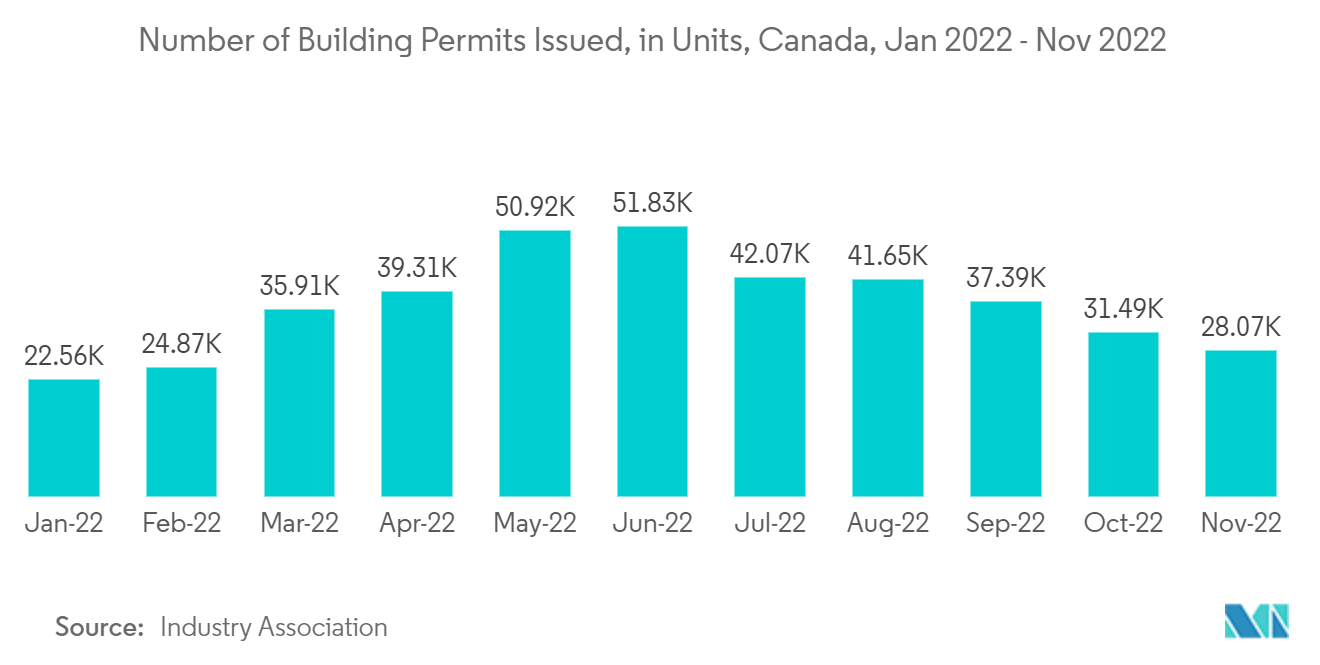
Slow Down of Construction Cost Growth
In the third quarter of 2022, residential building construction costs increased 2.5%. The growth was slower than in the second quarter, where residential construction costs grew 5.3%. The rate of growth for residential building construction costs has notably slowed when compared to the past year and a half. Contractors attributed part of the growth in building construction costs to skilled labor shortages and high labor costs. Despite a decline in the number of vacancies for construction jobs from April to July, the vacancy rate remains high, which has kept upward pressure on wages in the industry. Labor contract renegotiations also contributed to higher labor costs in the third quarter. Additionally, higher material costs, amid the limited availability of materials and equipment, particularly concrete, steel, glass and piping, contributed to higher costs. Contractors also noted that fuel prices continue to add upward pressure on construction costs.
Growth in residential building construction costs decelerated during the third quarter, with 10 of the 11 census metropolitan areas (CMAs) recording smaller quarterly increases than the previous two quarters. This slowdown was largely driven by declining softwood lumber prices that have materialized amid a downswing in US housing construction. Costs to construct residential buildings increased the most in Toronto (+4.2%) in the third quarter, followed by Vancouver (+1.9%) and St. John's (+1.7%). In Saskatoon, although high-rise residential building construction costs rose, declines in costs for single-detached houses and townhouses allowed Saskatoon to be the only CMA where residential building construction costs declined in the third quarter (-0.1%). Construction costs for residential buildings rose the most in Toronto, where costs for building low-rise apartments were the highest. By building type, high-rise apartment building construction costs recorded the greatest increase (+3.0%) in the third quarter of 2022, led by Toronto (+3.9%), and followed by Vancouver and Calgary (each up by 2.0%). Single-family homes were the buildings with the highest construction price increase in Canada in 2022.
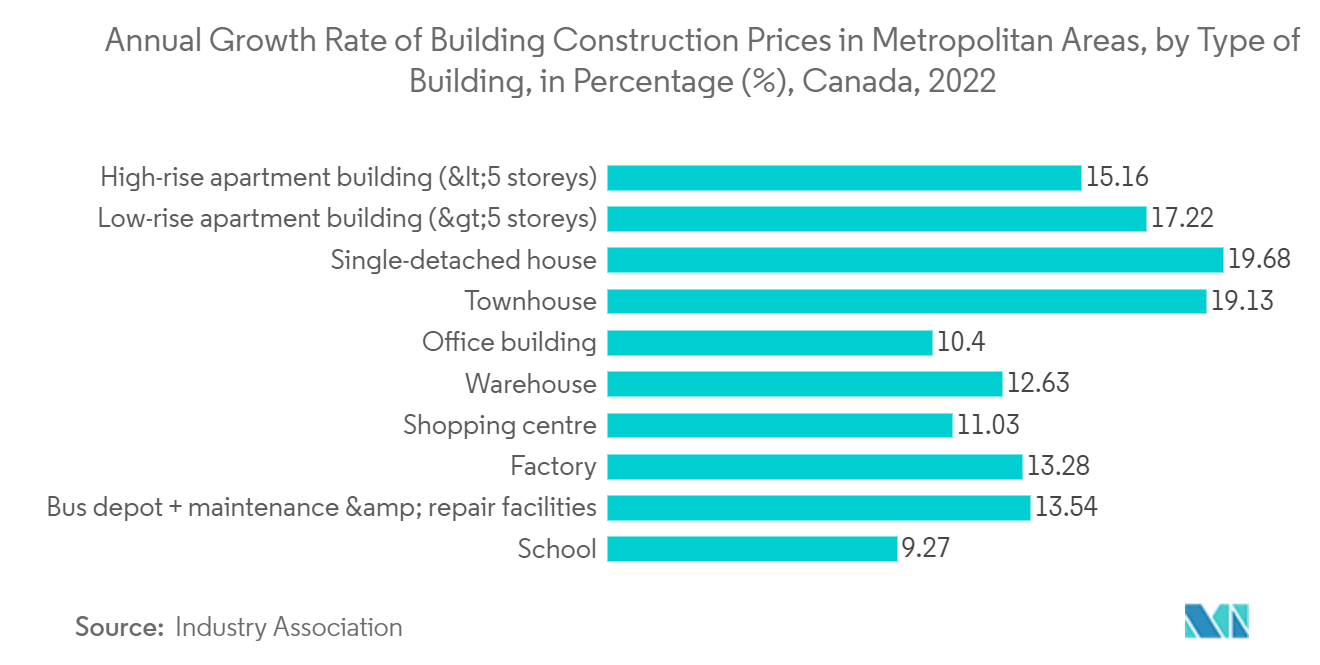
Canada Residential Construction Industry Overview
The Canadian residential construction Market is fragmented and highly competitive, with the presence of major local and international players. However, opportunities are opening up for small and medium players due to increasing govt investments in the sector. Major players in the market include PCL Construction, EllisDon Corporation, Graham Construction, Ledcor Group of Companies, and Bird Construction Incorporated. The market presents opportunities for growth during the forecast period, which is expected to drive market competition further. Major players are competing among themselves for an increase in market share which leaves the industry with no observable levels of consolidation.
Canada Residential Construction Market Leaders
-
PCL Construction
-
EllisDon Corporation
-
Graham Construction
-
Ledcor Group of Companies
-
Bird Construction Incorporated
*Disclaimer: Major Players sorted in no particular order
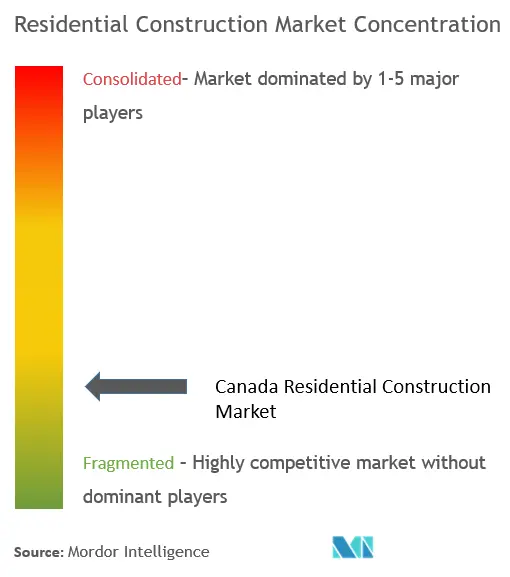
Canada Residential Construction Market News
- September 2022: PCL Construction was awarded Kindred Resort - Keystone's first major development in River Run in 20 years. This USD 184 million, 321,000 square-foot mixed-use development, designed by OZ Architecture, will consist of 95 luxury ski-in/ski-out condominiums and a 107-key full-service hotel, all just steps away from the River Run Gondola at Keystone Ski Resort. The development also includes 25,000 square feet of commercial space for restaurants, retail, and amenities including a pool, spa, fitness center, ski club, and event space. Preliminary construction activities are underway to relocate utilities. Construction will continue year-round and is scheduled for completion in June 2025.
- January 2023: PCL Construction broke ground on Schnitzer West Living's luxury residential community, the Avant, in the Denver Tech Center. The Avant is situated on the corner of Greenwood Plaza Boulevard and East Caley Avenue. The property includes 337 highly curated for-rent residences, complete with modern amenities and a two-level indoor structured parking garage with a capacity for roughly 450 cars. Residents will enjoy commanding views of the surrounding mountains year-round from their homes and the property's outdoor pool and hot tub. The property is Schnitzer West's first multifamily residential building, bringing luxurious living experiences to Denver's Tech Center.
Canada Residential Construction Market Report - Table of Contents
1. INTRODUCTION
- 1.1 Study Assumptions and Market Definition
- 1.2 Scope of the Study
2. RESEARCH METHODOLOGY
3. EXECUTIVE SUMMARY
4. MARKET INSIGHTS AND DYNAMICS
- 4.1 Current Market Scenario
- 4.2 Market Drivers
- 4.3 Market Restraints
- 4.4 Market Opportunities
- 4.5 Value Chain / Supply Chain Analysis
-
4.6 Industry Attractiveness - Porter's Five Forces Analysis
- 4.6.1 Threat of New Entrants
- 4.6.2 Bargaining Power of Buyers/Consumers
- 4.6.3 Bargaining Power of Suppliers
- 4.6.4 Threat of Substitute Products
- 4.6.5 Intensity of Competitive Rivalry
- 4.7 Insights on Government Regulations in the Market
- 4.8 Insights on Technological Advancements in the Market
- 4.9 Residential Construction Cost Analysis
- 4.10 Impact of COVID-19 on the Market
5. MARKET SEGMENTATION
-
5.1 By Type
- 5.1.1 Single Family
- 5.1.2 Multi Family
-
5.2 By Key City
- 5.2.1 Edmonton
- 5.2.2 Calgary
- 5.2.3 Toronto
- 5.2.4 Vancouver
- 5.2.5 Ottawa
- 5.2.6 Montreal
- 5.2.7 Rest Of Canada
6. COMPETITIVE LANDSCAPE
- 6.1 Market Concentration Overview
-
6.2 Company Profiles
- 6.2.1 PCL Construction
- 6.2.2 EllisDon Corporation
- 6.2.3 Graham Construction
- 6.2.4 Ledcor Group of Companies
- 6.2.5 Pomerleau Incorporated
- 6.2.6 Bird Construction Incorporated
- 6.2.7 Broccolini
- 6.2.8 EBC Incorporated
- 6.2.9 Clark Builders
- 6.2.10 Magil Construction
- 6.2.11 Taggart Group of Companies
- 6.2.12 Maple Reinders Constructors Limited
- 6.2.13 Chandos Construction
- 6.2.14 Dawson Wallace Construction Limited
- 6.2.15 Urban One Builders
- 6.2.16 Buttcon Limited
- 6.2.17 Delnor Construction Limited
- 6.2.18 Turner Construction Company
- 6.2.19 Marco Group of Companies
- 6.2.20 Matheson Constructors*
- *List Not Exhaustive
7. FUTURE OF THE MARKET
8. APPENDIX
** Subject To AvailablityCanada Residential Construction Industry Segmentation
Residential construction is a process that involves the expansion, renovation, or construction of a new home or spaces intended to be occupied for residential purposes. These spaces can be anything from rental spaces, condominiums, and luxury mansions, to single-family housing projects. The Canadian residential construction market is segmented by Type (Single Family, and Multi-Family), and by Key City (Edmonton, Calgary, Toronto, Vancouver, Ottawa, Montreal, and rest of Canada). The report offers market sizes (USD billion) and forecasts for all the above segments.
| By Type | Single Family |
| Multi Family | |
| By Key City | Edmonton |
| Calgary | |
| Toronto | |
| Vancouver | |
| Ottawa | |
| Montreal | |
| Rest Of Canada |
Canada Residential Construction Market Research FAQs
What is the current Canada Residential Construction Market size?
The Canada Residential Construction Market is projected to register a CAGR of greater than 5% during the forecast period (2024-2029)
Who are the key players in Canada Residential Construction Market?
PCL Construction, EllisDon Corporation, Graham Construction, Ledcor Group of Companies and Bird Construction Incorporated are the major companies operating in the Canada Residential Construction Market.
What years does this Canada Residential Construction Market cover?
The report covers the Canada Residential Construction Market historical market size for years: 2020, 2021, 2022 and 2023. The report also forecasts the Canada Residential Construction Market size for years: 2024, 2025, 2026, 2027, 2028 and 2029.
Canada Residential Construction Industry Report
Statistics for the 2024 Canada Residential Construction market share, size and revenue growth rate, created by Mordor Intelligence™ Industry Reports. Canada Residential Construction analysis includes a market forecast outlook to (2024to2029 and historical overview. Get a sample of this industry analysis as a free report PDF download.



